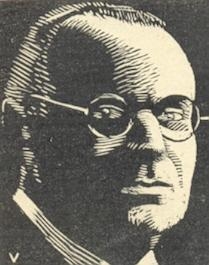
Edward Winter

Woodcut of Aron Nimzowitsch by Erwin Voellmy (Schweizerische Schachzeitung, September 1929, page 138)
Page 138 of Schach 2000 Jahre Spiel-Geschichte by R. Finkenzeller, W. Ziehr and E. Bührer (Stuttgart, 1989) ascribed to Tartakower a remark quoted as ‘Eine Drohung ist stärker als eine Ausführung’. In the English-language edition (London, 1990) that came out lumberingly as ‘A threat is more effective than the actual implementation’, whereas the usual rendering is ‘The threat is stronger than the execution’. Moreover, Nimzowitsch, rather than Tartakower, is customarily named as the coiner of the phrase, with everything tied into the famous ‘smoking threat’ anecdote.
On page 191 of the July 1953 CHESS M. Lipton pointed out two contradictory versions of the story of Nimzowitsch complaining that his opponent was threatening to smoke. On pages 31-32 of Chess for Fun & Chess for Blood (Philadelphia, 1942) Edward Lasker asserted that the incident, involving a cigar, had occurred ‘in an offhand game between Nimzowitsch and Emanuel Lasker in Berlin’ (although there was still, according to Edward Lasker’s account, an umpire to whom Nimzowitsch could protest). On page 128 of The World’s Great Chess Games (New York, 1951) Reuben Fine stated that the scene had been New York, 1927, and that Nimzowitsch complained to the tournament director, Maróczy, when Vidmar ‘absent-mindedly took out his cigarette case’.
New York, 1927 was also given as the venue by Irving Chernev (‘This is the way I heard it back in 1927, when it occurred’) on pages 15-16 of The Bright Side of Chess (Philadelphia, 1948). Nimzowitsch, we are told, complained to the tournament committee that Vidmar looked as if he wanted to smoke a cigar, but Chernev mentioned no remark about the threat being stronger than the execution.
It is not possible to say when the story first appeared in print. After Alfred Brinckmann had related it in Deutsche Schachblätter in 1932, the BCM (page 307 of the July 1932 issue) accorded it 16 lines, stating that Nimzowitsch’s objection to tobacco smoke was well known but that ‘A. Brinckmann tells what is to us a new story in this connection’. According to the Brinckmann version (New York, 1927, Vidmar, cigars), the Nimzowitsch punchline to the unnamed tournament director was ‘No, but he is threatening to smoke, and as an old player you must know that the threat is stronger than the execution’.
On page 158 of the May 1954 BCM D.J. Morgan stated regarding the Nimzowitsch story:
‘The original version in the Evening Standard was contributed by its then chess editor, H. Meek, and we have our friend Mr Meek’s authority for saying that he received the story by word of mouth from Maróczy, the controller of the tournament in question (New York, 1927).’
None of this explains why Tartakower’s name has been seen or, indeed, when the epigram first evolved. All we can say for now is that in 1932 Tartakower contributed a two-part article on the subject of threats to Les Cahiers de l’Echiquier Français and that in the second part (issue 28, page 373) he wrote:
‘Pour conclure, invitons le lecteur à réfléchir sur les considérations suivantes:
1. Puisque “la menace est plus forte que l’exécution”, il n’est pas paradoxal de prétendre qu’il est plus fort de ne pas user de la menace. Qu’on appelle cette stratégie “louvoiement”, “jeu positionnel” ou “stratégie d’attente”, c’est une façon de jouer qui est très pratiquée dans les grands tournois et qui donne souvent de bons résultats, car il peut en résulter chez l’adversaire une moindre vigilance. Elle peut, en outre, lui faire perdre patience et le pousser à s’élancer dans une attaque prématurée.’
How far back is it possible to trace the ‘threat/execution’ remark, in the writings of Tartakower, Nimzowitsch or anybody else? And did Maróczy ever pen an account of any such Nimzowitsch incident at New York, 1927?
(3197)
Peter Anderberg (Harmstorf, Germany) notes that the above-mentioned feature by Alfred Brinckmann was published on page 50 of the 15 February 1932 issue of Deutsche Schachblätter:

From Per Skjoldager (Fredericia, Denmark):
‘The only example I can find of Nimzowitsch using the phrase about the threat being stronger than the execution is on page 137 of the 9/1933 issue of the Danish magazine Skakbladet, where he annotated his game against I.E.W. Gemzøe (who was Black) from that year’s Politiken training tournament in Copenhagen:

Black played 20…Qe7, and Nimzowitsch wrote:
‘This retreat by the strongly-posted queen is an excellent move. The pawn at e5 is now heading for its sad fate. It should be noted that Black has continually operated with the threat of …Qxa2 without executing it (the modern doctrine, which says that the threat is stronger than the execution).’
For reference, his original Danish text reads:
“Dette tilbagetog af den stærkt posterede dronning er et fortrinligt træk: Be5 går nu sin triste skæbne i møde. Læg mærke til, at sort bestandig har opereret med truslen Dxa2 uden dog at udføre den (den moderne lærdom, der siger, at truslen er stærkere end udførelsen).”’
(3200)
Despite Nimzowitsch’s well-known dislike of tobacco, page 87 of Visiting Mrs Nabokov by Martin Amis (London, 1993) affirmed that ‘Nimzowitsch used to smoke an especially noxious cigar’.
We have now found a much older and more extensive version of the alleged Nimzowitsch observation discussed in C.N.s 3197 and 3200. From pages xiv-xv of Chess Openings by James Mason (London, 1897):
‘A threat or menace of exchange, or of occupation of some important point, is often far more effective than its actual execution. For example, in the Ruy López impending BxKt causes the defender much uneasiness. He is, to some extent, obliged to confound the possible with the probable; while yet at the same time in serious doubt as to what may really happen.
Consequently, when you are attacking a piece or pawn that will keep; when you cannot be prevented from occupying some point of vantage, from which your adversary may be anxious to dislodge you; when you can check now or later, with at least equal effect; in these and all such circumstances – be cautious. Do not play a good move too soon. For when you do play it, the worst of it becomes known to your antagonist, who, then free from all doubt or apprehension as to its future happening, is enabled to order his attack or defence accordingly. Therefore reserve it reasonably, thus stretching him on the rack of expectation, while you calmly proceed in development, or otherwise advance the general interests of your position.’
(3257)
In Visiting Mrs Nabokov the article by Martin Amis, on pages 83-93, was entitled ‘Chess: Kasparov v. Karpov’. It originally appeared under the title ‘The Masters and the Mafia’ on pages of 17-18 of the Observer Review, 27 July 1986.
Relating the Nimzowitsch anti-smoking anecdote on pages 104-105 of their book Chess Panorama (Radnor, 1975), W. Lombardy and D. Daniels presented the punch-line as follows:
‘“I know”, Nimzowitsch replied, “but he threatens to smoke, and you know as well as I that in chess the threat is often stronger than the execution”. (This was one of the basic principles elaborated in Nimzowitsch’s brilliant work My System.)’
In fact, the only instance found so far of Nimzowitsch putting forward this principle was in a 1933 magazine article (see C.N. 3200).
C.N. 3257 referred to an 1897 book by James Mason which contained the concept (‘A threat or menace of exchange, or of occupation of some important point, is often far more effective than its actual execution’), but now Peter Anderberg (Harmstorf, Germany) points out to us that according to Georg Marco (on page 111 of the March-April 1908 Wiener Schachzeitung) the principle had long been followed by instinct but was first formulated by Karl Eisenbach (1836-1894). This claim came at the end of the annotated game Lasker v Napier, Cambridge Springs, 1904:
‘Lasker folgte dabei dem längst instinktiv befolgten, aber erst von Karl Eisenbach formulirten Prinzip: “Die Drohung ist stärker als die Ausführung”.’
A footnote described Eisenbach as one of the deepest chess thinkers: ‘Sekretär der Wiener Schachgesellschaft, einer der gründlichsten Schachdenker, † 1894’.
(3360)
In a list of ‘maxims and advice’ on page 229 of A Breviary of Chess (London, 1937) Tartakower included ‘A threat is more powerful than its execution’, and attributed it to Tarrasch.
(4328)
On page 49 Tartakower wrote: ‘Bear in mind that very frequently the threat is more powerful than its execution.’
From Bernd Graefrath (Mülheim/Ruhr, Germany):
‘ [C.N. 3360 above] gives a quotation from page 111 of the March-April 1908 Wiener Schachzeitung which claimed that [Karl Eisenbach] had formulated the principle about the threat being stronger than the execution. I would add that the point was made again on page 151 of the May-June 1908 issue:
“Wichtiger als die vorgeführten Details ist aber die Tatsache, daß auch hier das Eisenbachsche Prinzip sich bewährt: ‘Die Drohung ist oft stärker als die Ausführung.”’
(4366)
Now we note that in CHESS, 30 September 1963 (‘page 400’, but in fact page 12) Salo Flohr brought in a different name:
‘I remember an incident involving Grandmaster Nimzowitsch. He couldn’t bear tobacco smoke, and in one tournament he set as a condition that his opponent should not smoke.
His rivals agreed. When Bogoljubow put a full box of cigars on the table before sitting down to play against him, he hurried to the chief umpire in great excitement.
The umpire checked up and said, “But Bogoljubow isn’t smoking”.
“I know he isn’t”, Nimzowitsch fumed, “but he threatens to do so, and the threat in chess is more powerful than the execution.”’
Flohr was not necessarily claiming to have been an eye-witness, but it may be recalled that the incident is usually placed at New York, 1927, where neither Bogoljubow nor Lasker participated.
(4496)
From Joost van Winsen (Silvolde, the Netherlands):
‘The story was also told by Gerard Oskam on page 41 of Schaakmat, February 1951. He wrote that Aron Nimzowitsch set the condition that there should be no smoking by his opponents, who included H. Weenink (1892-1931). Oskam stated that the incident occurred before the game between Nimzowitsch and Tartakower, and he reproduced dialogue allegedly exchanged between the two masters.
There are, though, problems with Oskam’s story. He said that it happened in Liège in 1923, but no such tournament took place. Nimzowitsch, Tartakower and Weenink did participate in Liège, 1930, but Oskam stated that it took Nimzowitsch 35 minutes to make his first move, 1 e4; at Liège, 1930 Nimzowitsch was Black against Tartakower, in a Caro-Kann Defence which was drawn after 20 moves. In fact, Oskam’s article indicated that Tartakower was not a smoker, which is corroborated by Kmoch and Reinfeld’s list quoted on page 235 of A Chess Omnibus.
Vidmar discussed his own cigar-smoking habits (including a story involving Tartakower at London, 1922) on page 114 of his memoirs Goldene Schachzeiten (Berlin, 1961).’
The smoking anecdote was also related by G. Koltanowski on pages 441-442 of CHESS, 14 August 1936. He called it ‘an old but very good story’ which had occurred ‘years ago’ in ‘a double round tournament’ and he spread out the action, involving Nimzowitsch and Vidmar (plus pipe), over the two rounds in which they faced each other. Nimzowitsch was stated to have complained to Maróczy, the tournament director. That suggests New York, 1927, except that it was not ‘a double round tournament’. As so often, Koltanowski purported to present the actual words spoken by the protagonists, but when he related the story again on page 13 of his 1968 book TV Chess, the actual words were altogether different.
(4505)
On page 97 of Caïssas Weltreich by Max Euwe and Bob Spaak (Berlin-Frohnau, 1956) the would-be smoker was Bogoljubow:
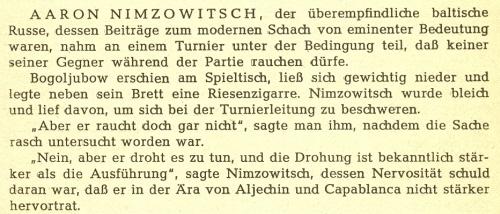
(5601)
Regarding the anecdote about an opponent who threatened to smoke, the longest version known to us is on pages 4-5 of The Pleasures of Learning Chess by Fairfield W. Hoban (New York, 1974). Forty lines of text, with abundant direct speech, are squeezed out of the alleged episode. After Lasker’s cigar has been ‘slowly and carefully unwrapped’ and Nimzowitsch has ‘exploded, leaping to his feet and shouting for the tournament director’, Lasker says, ‘What seems to be the trouble, Aron?’ In reply, Nimzowitsch howls, ‘You know very well what the trouble is’ and accuses Lasker of trying ‘to interfere with my thinking and to ruin my game and I won’t have it!’
The tournament director, Maróczy, is given hardly any dialogue, stilted or otherwise, and the apogee is a final rant by Nimzowitsch:
‘“But that isn’t the point! That isn’t the point!,” shrieked the now-hysterical master. “Everyone knows that Dr Lasker has written that the threat is much stronger than the execution!”’
(6677)
Another version, from page 134 of How to Play Winning Chess by Fred Reinfeld (New York, 1962):
‘On one occasion during an important tournament Dr Vidmar playfully placed his cigar case, full of cigars, on the playing table. Though Vidmar showed no sign of wanting to smoke, Nimzowitsch was greatly agitated. Finally, unable to control himself any longer, he ran off to the tournament director with his complaint.
Trying to soothe him, the tournament director pointed out that Vidmar was not actually smoking. “Yes, that’s true”, Nimzowitsch answered, “but he might. And you know that in chess, the threat is stronger than the fulfillment”.’
From page 369 of Aron Nimzowitsch On the Road to Chess Mastery, 1886-1924 by Per Skjoldager and Jørn Erik Nielsen (Jefferson, 2012):
‘The anecdotes have, of course, left the impression that Nimzowitsch disliked smoking very much. But the drawing of Nimzowitsch from the tournament in Copenhagen 1923, however, discloses Nimzowitsch to be – a smoker. A letter from his younger brother Benno to Professor Becker, written in 1935, confirms, though with a chronological vagueness, that Aron was a diligent smoker “when he was young”. The letter also said that he had to give it up because of health problems. Like many other ex-smokers, Nimzowitsch then developed a strong dislike for tobacco smoke.’
The sketch in question is shown below, courtesy of Mr Skjoldager:

(7832)
The space-filling potential of the smoking-threat anecdote involving Nimzowitsch and a variable supporting cast (Lasker, Vidmar, Tartakower, Bogoljubow, Maróczy and Lederer) is a godsend for a certain type of ahistorical chess author. He may even decide to write a playlet:
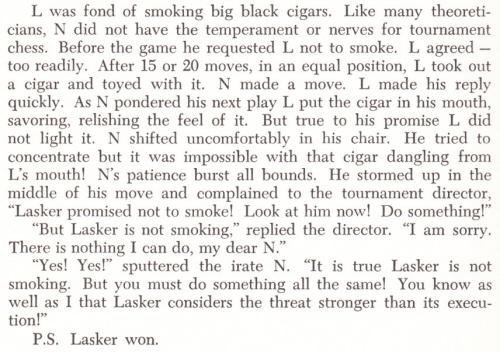
Source: page 86 of Chess Beginner to Expert by Larry Evans (Wellesley Hills, 1967).
(8249)
From a note on page 201 of 500 Master Games of Chess by S. Tartakower and J. du Mont (London, 1952):
‘... illustrating the principle that the threat is stronger than its execution ...’
See too Chess: Jacqueline and Gregor Piatigorsky.
In all the citations of the phrase ‘the threat is stronger than the execution’, whether or not connected to the smoking anecdote, a name not seen so far is Capablanca. However, we now add a ‘once’ version on page 200 of a book by W. Ritson Morry and W. Melville Mitchell, which, as mentioned in C.N. 8818, was published in the 1960s and 1970s under a range of titles (Chess: A Way to Learn; Chess The Elements and the Play; Tackle Chess This Way; Tackle Chess; Chess Theory and Practice):
‘Dr Vidmar once promised to refrain from smoking in a game with Nimzowitsch, but in mid-session the latter approached the controller very agitatedly saying “You remember Vidmar promised not to smoke?” “Yes”, replied the controller. “But he isn’t.” “Ah”, came the reply, “but he looks as if he wants to, and you know that Capablanca said a threat is stronger than its execution.”’
(8818)
Mike Salter (Sydney, Australia) notes that another version of the alleged Nimzowitsch anti-smoking incident was related by Carl Ahues in an article, ‘Aus dem reichen Schatz meiner Erinnerungen’, on pages 120-121 of the 8/1954 issue of Schach (‘2. Aprilheft 1954’). From page 120:
‘Hier möchte ich noch eine Anekdote einfügen, die sich im New-Yorker Turnier ereignet haben soll. Nimzowitsch hatte Dr. Vidmar gebeten, während ihrer Partie nicht zu rauchen. Letzterer hatte sich damit einverstanden erklärt, aber mit der Einschränkung, daß er nur dann eine Zigarre nehmen würde, wenn er in eine sehr schlechte Stellung geraten sollte. Das Treffen verlief nikotinfrei, aber Dr. Vidmar gewann! Der verärgerte Nimzowitsch beschwerte sich darauf beim Turnierleiter Maróczy über das “verdammte Rauchen”. “Aber Ihr Gegner hat doch gar nicht geraucht”, war die erstaunte Antwort. “Nicht geraucht? Viel schlimmer als das! Er hat mich mit Rauchen bedroht. Er hatte seine Zigarre neben das Brett gelegt, so daß ich mir sagte: Machst du jetzt einen starken Zug, nimmt er eine Zigarre. Wie kann ich dabei gewinnen! Daß die Drohung stärker ist als die Ausführung, sollten Sie als Schachspieler ja wohl wissen.” – Armer Nimzowitsch! – Wie manche seiner Meisterkollegen war er auch sehr abergläubisch. “Wenn ich eine Partie verliere, ziehe ich mir sofort einen anderen Anzug an”, sagte er einmal zu mir. Übrigens kann ich mich persönlich über ihn kaum beklagen; für mich war er immer ein angenehmer Kamerad.’
(9913)
C.N. 3197 (see above) quoted a remark by Tartakower on page 373 of issue 28 of Les Cahiers de l’Echiquier Français (1932):
‘1. Puisque “la menace est plus forte que l’exécution”, il n’est pas paradoxal de prétendre qu’il est plus fort de ne pas user de la menace. Qu’on appelle cette stratégie “louvoiement”, “jeu positionnel” ou “stratégie d’attente”, c’est une façon de jouer qui est très pratiquée dans les grands tournois et qui donne souvent de bons résultats, car il peut en résulter chez l’adversaire une moindre vigilance. Elle peut, en outre, lui faire perdre patience et le pousser à s’élancer dans une attaque prématurée.’
Christian Sánchez (Rosario, Argentina) notes that the article had previously appeared on pages 132-134 of El Ajedrez Americano, May 1931, with this slightly different text on page 134:
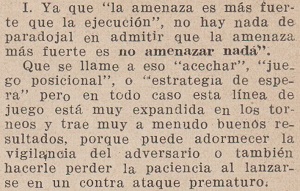
From page 65 of Il lessico degli scacchi by Yuri Garrett (Brescia, 2012):
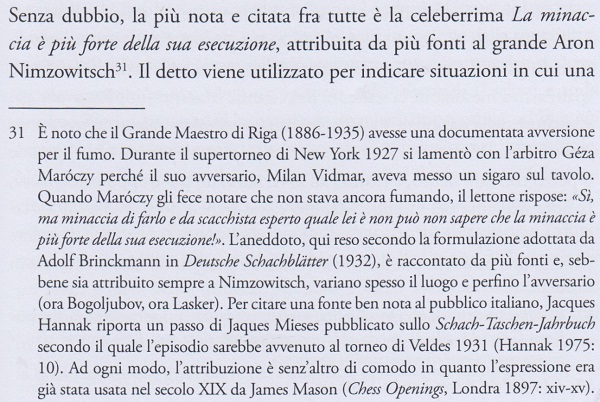
Any assumption that the footnote is the result of original research by Mr Garrett will be dispelled by scrutiny of our feature article A Nimzowitsch Story. He can, though, take responsibility for ‘Adolf’ (instead of Alfred) Brinckmann, as well as for ‘Jaques’ (instead of Jacques) Mieses.
Mieses’ reminiscences about Nimzowitsch did not assert that the smoking incident occurred at Bled, 1931, and the footnote in Il lessico degli scacchi provides another example of the perils of blind copying. The reference ‘Hannak 1975: 10’ concerns a 1970s Italian translation of Nimzowitsch’s Mein System which contained, on pages 5-33, an introductory essay by J. Hannak entitled ‘Vita di un pessimista’. From page 10 of that book, Il mio sistema:
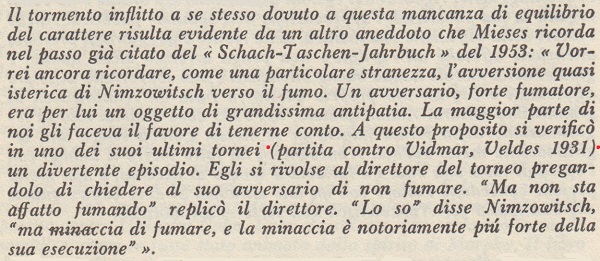
It is indeed indicated that Mieses’ article in the Schach-Taschen-Jahrbuch 1953 stated that the smoking incident occurred in a game between Nimzowitsch and Vidmar at Bled, 1931, but Hannak’s original German text, ‘Lebenslauf eines Pessimisten’ in Mein System (Berlin-Frohnau, 1958), shows that the mention of Bled, 1931 was not by Mieses but was an editorial addition by Hannak himself. From page 13:
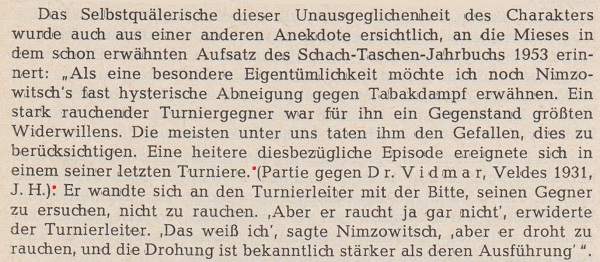
Below, courtesy of the Cleveland Public Library, is the relevant passage from Mieses’ article, ‘Erinnerungen an Nimzowitsch’, on page 43 of Schach-Taschen-Jahrbuch 1953:
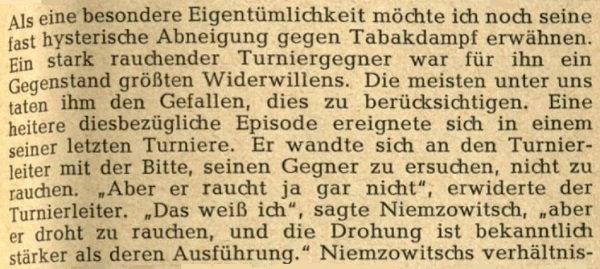
The heading on page 37:

Nor, naturally enough, was there any mention of Bled, 1931 in an earlier, very similar, article by Mieses, ‘Recollections of A. Nimzowitsch’, on pages 241-244 of the August 1947 BCM. From page 244:

The question now is why Hannak specified that the smoking incident occurred during one of the Nimzowitsch v Vidmar games (two short draws) at Bled, 1931.
(10322)
See too Articles about Aron Nimzowitsch.
To the Chess Notes main page.
To the Archives for other feature articles.
Copyright: Edward Winter. All rights reserved.